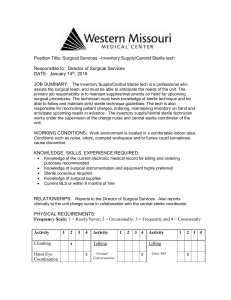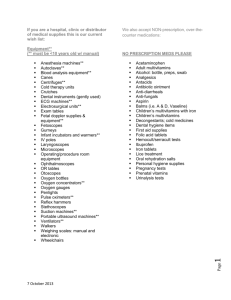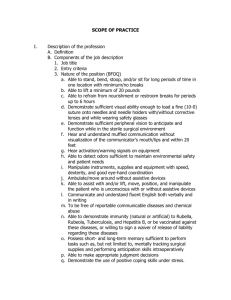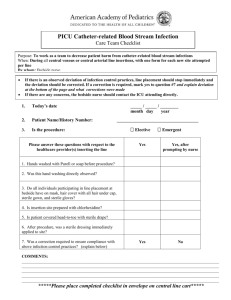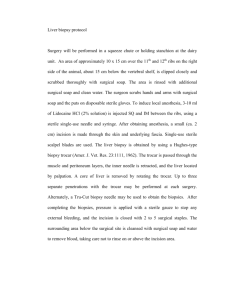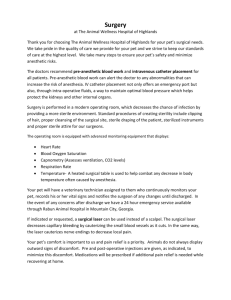Standard Creating Sterile Field - Association of Surgical Technologists
advertisement
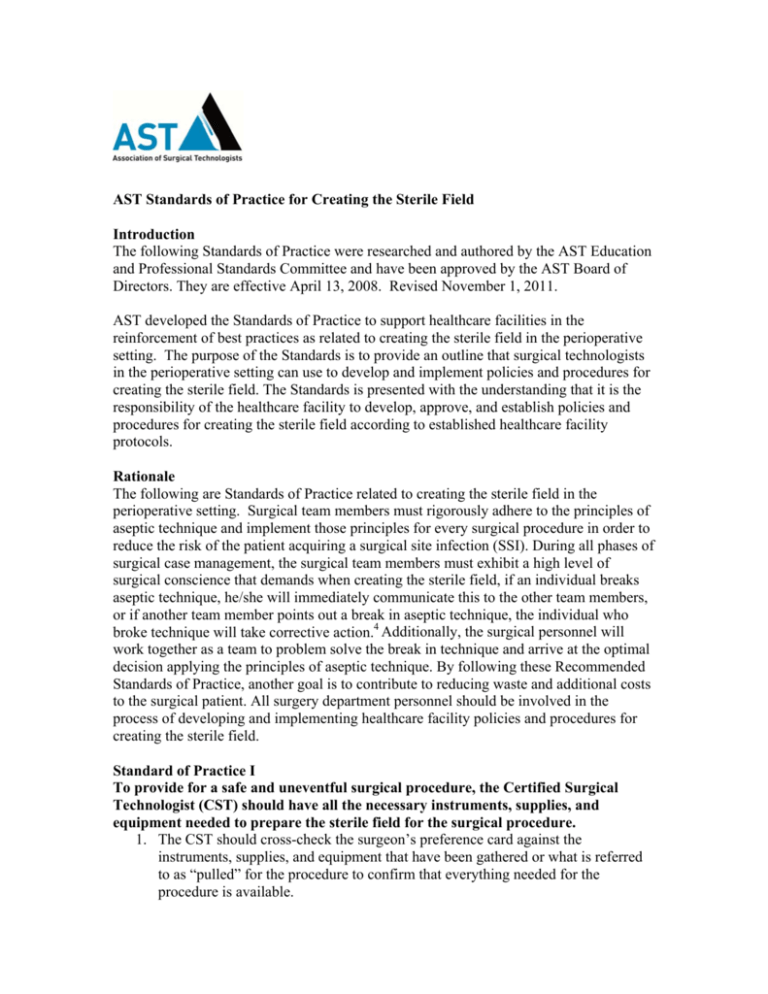
AST Standards of Practice for Creating the Sterile Field Introduction The following Standards of Practice were researched and authored by the AST Education and Professional Standards Committee and have been approved by the AST Board of Directors. They are effective April 13, 2008. Revised November 1, 2011. AST developed the Standards of Practice to support healthcare facilities in the reinforcement of best practices as related to creating the sterile field in the perioperative setting. The purpose of the Standards is to provide an outline that surgical technologists in the perioperative setting can use to develop and implement policies and procedures for creating the sterile field. The Standards is presented with the understanding that it is the responsibility of the healthcare facility to develop, approve, and establish policies and procedures for creating the sterile field according to established healthcare facility protocols. Rationale The following are Standards of Practice related to creating the sterile field in the perioperative setting. Surgical team members must rigorously adhere to the principles of aseptic technique and implement those principles for every surgical procedure in order to reduce the risk of the patient acquiring a surgical site infection (SSI). During all phases of surgical case management, the surgical team members must exhibit a high level of surgical conscience that demands when creating the sterile field, if an individual breaks aseptic technique, he/she will immediately communicate this to the other team members, or if another team member points out a break in aseptic technique, the individual who broke technique will take corrective action.4 Additionally, the surgical personnel will work together as a team to problem solve the break in technique and arrive at the optimal decision applying the principles of aseptic technique. By following these Recommended Standards of Practice, another goal is to contribute to reducing waste and additional costs to the surgical patient. All surgery department personnel should be involved in the process of developing and implementing healthcare facility policies and procedures for creating the sterile field. Standard of Practice I To provide for a safe and uneventful surgical procedure, the Certified Surgical Technologist (CST) should have all the necessary instruments, supplies, and equipment needed to prepare the sterile field for the surgical procedure. 1. The CST should cross-check the surgeon’s preference card against the instruments, supplies, and equipment that have been gathered or what is referred to as “pulled” for the procedure to confirm that everything needed for the procedure is available. Standard of Practice II The OR furniture and equipment should be grouped and positioned prior to opening the sterile items. 1. The CST should verify that all furniture, eg IV stands, sitting stools, anesthesia provider’s cart, and equipment, eg electrosurgical unit, suction system, are in the OR. A. Any unnecessary furniture and equipment should be removed from the OR3 B. Equipment, eg electrosurgical unit, patient monitors, suction system, and specialty equipment, such as tourniquet machine, microscope, etc should be tested for functionality prior to the start of the procedure. C. New suction liners should be placed in the suction canister and confirm that the suction tubing is connected to the wall vacuum outlet. D. Confirm that a separate suction system is prepared for use by the anesthesia provider.3 2. Furniture should be grouped and positioned. A. Furniture that will eventually be sterilely draped including the backtable, Mayo stand and basin ring stand should be grouped and organized together. It is recommended these items be positioned so that the sterile field will be established in an area furthest from the OR door. When the OR doors open and close, this causes air movement in which particles are stirred up, therefore the furniture should be positioned as far as possible from the OR doors and human traffic that occurs in and out of the room.3 B. The furniture that will be set up and included in the sterile field should be positioned 12-18 inches away from the wall and other non-sterile furniture and equipment. 3. All other furniture that will not be included in the sterile field, eg linen and trash hampers, sponge/kick buckets, sitting stools, should be positioned away from the furniture to be used in the sterile field and away from traffic patterns. A. A biohazard bag should be positioned in the linen and trash hampers. B. Sponge buckets should be lined with an impervious biohazard bag. 4. The OR table should be positioned according to the surgeon’s preference under the OR lights. 5. The anesthesia machine should be positioned according to the anesthesia provider’s preference and according to the position of the OR table. A. A clean, lift sheet and armboard covers should be placed on the OR table. 5 B. Safety strap should be correctly positioned on the OR table. Standard of Practice III Aseptic technique must be strictly adhered to by the surgical team members when opening sterile instrument sets, packages and peel packs. 1. Sterile items should be positioned for use in the OR, eg backtable pack placed on backtable, basin placed in ring stand, instrument sets placed on flat surfaces, skin prep tray placed on prep table. The items should be placed on clean, dry surfaces. Items that will not be immediately opened, such as sterile dressing supplies are placed in a location where they will be easily accessible by the circulator. 2. Prior to opening a sterile item, the following should be verified: A. The external chemical indicator or integrator has changed color indicating the item has been exposed to a sterilization process. B. The integrity of the packaging material is intact, eg no perforations, tears or evidence of strike-through. C. Confirm expiration date, if present. 3. The surgical team members should establish a routine for opening sterile items. A. The following is a recommended sequence for opening sterile items: (1) Backtable pack (2) Basin set (3) Small wrapped items, eg sterile towel pack (4) Peel pack items, including suture B. The CST’s gown and gloves should be opened on a separate flat surface, such as the Mayo stand. C. Small wrapped items, peel packs and suture packets should be opened and “flipped” onto the sterile field using aseptic technique. The glued area of peel packs and suture packets is considered the boundary between nonsterile and sterile. Items should be opened in such manner that the nonsterile person is not extending over the sterile field. D. Peel packs that contain a heavy or difficult item(s), eg pliers, multiple clamps, should not be opened and flipped onto the sterile field. The item could puncture the sterile cover. The item should be opened into a basin on a ring stand or preferably a non-scrubbed person should open the peel pack and pass the sterile item(s) using aseptic technique to the CST in the first scrub role. E. Items should be opened in a grouping manner the same way on all cases to establish a logical, sequential, and efficient routine for creating the sterile field. (1) The grouping of items minimizes movement and contributes to the efficiency of the set up. (2) Items opened in a grouping manner allow the CST to easily identify and locate similar items (e.g. all of the drapes are opened in the same area of the backtable. (3) Sharps should be grouped on one corner of the backtable and other items should not be opened near the sharps. This aids in minimizing the risk of an accidental sharps injury during the set up. (4) Items such as drapes should be opened in reverse order of use (eg, the last drape to be used will be opened first so it will be on the bottom and the first drape will on top). This minimizes movement and contributes to efficiency. 4. Rigid instrument containers should be inspected prior to opening. A. The filter and/or valve system should be inspected to confirm they are intact.5 B. The tray locking mechanisms should be checked for integrity, and if the chemical indicator on the seal lock changed color to confirm that the container was exposed to a sterilization process. C. If the container does not meet these inspection criteria, it must be considered contaminated and not used. D. The lid should be lifted upward, take a step back and away from the container to prevent contamination. E. Containers that have a gasket should be checked to make sure the gasket is intact. If the gasket is not intact, the set should be considered contaminated. 5. If a sterile package is dropped, the package may be considered safe for immediate use if wrapped in impervious packaging, the area of contact is dry, and the integrity of the packaging is maintained. The package should not be placed back in sterile storage and must be immediately opened and placed on the sterile field. Sterile packages wrapped in reusable woven fabric packaging that have been dropped should not be opened, and the items should not be transferred to the sterile field; reusable fabric packaging allows air to implode into the package when it lands on the area of contact. Refer to the AST Recommended Standard of Practice for Sterile Wrapped Items Dropped on Floor for additional details. Standard of Practice IV Traffic in and out of the OR should be monitored and controlled when the surgical team begins to open sterile items. 1. The number of surgical personnel entering and leaving the OR should be monitored and controlled. Preferably only those surgical team members assigned to the surgical procedure should be entering and leaving the OR on a limited basis. A. Controlling the traffic aids in keeping air movement to a minimum, thus reducing the particles that enter the atmosphere and the amount of airborne contamination. (1) The doors to the OR should be kept closed to maintain a positive pressure. (2) If the OR has more than one entry, the doors to the main corridor should be used as little as possible. B. Controlling traffic aids in keeping the level of conversation that is occurring in the OR to a minimum in order to reduce the spread of airborne droplets, which can carry microorganisms.6 Standard of Practice V Sterile supplies should be opened as close to the time of surgery as possible and for one surgery only. 1. Only one patient should occupy an OR and therefore, a single sterile field should be created. A. The performance of two procedures when there are two sterile fields, two surgical teams and two surgical sites dramatically increases the risk for airborne particle and droplet cross-contamination. Additionally, surgical team personnel traffic patterns are limited, thus increasing the chance for contamination of a sterile surface or item. 2. Sterile fields should be created as close to the scheduled time of surgery as possible. A. The potential for airborne contamination increases with the length of time a sterile field has been open. Dust and particles from the ambient environment can settle onto the surfaces of the sterile field and items. Additionally, surgical personnel entering and leaving the OR stirs up dust and particles, which can settle on the surfaces. B. Currently, there is no research-based recommendation related to how long a sterile field can remain open without being used. As with sterile packages, the concept of event-related sterility applies to the sterile field. Healthcare facilities should establish policies that address the issue and best serve the needs of the facility. However, the policy should include that the sterile field is kept under constant observation in order to identify contamination that may occur and to control traffic in and out of the OR A sterile field that is not kept under constant observation should be considered non-sterile and broken down.5 3. If a patient is transported into the OR but, for unforeseen reasons, the surgical procedure is cancelled prior to its start, the sterile field and sterile items should be considered contaminated.5 The sterile field should be broken down, and the OR cleaned. It is recommended that the disposable items be saved and donated to a CAAHEP-accredited surgical technology program if one is near the healthcare facility. A. When sterile supplies have been opened, a sterile field created and a procedure cancels, but the patient was not brought into the OR, the room may still be used if the subsequent procedure is the same or similar.5 4. A sterile field, such as the sterile backtable should not be covered with a sterile cover or drape. Removing the cover in an aseptic manner that prevents contamination of the sterile field cannot be achieved since the sides of the cover are below the level of the surface of the table and most likely will touch the sterile field upon removal. Additionally, moving the cover upward stirs the air current in an upward direction causing airborne contamination of the sterile field. Therefore, a sterile field should not be covered for the purposes of moving it to another OR Standard of Practice VI To contribute to the efficiency of surgical patient care the CST in the first scrub role should implement the principles of economy of motion when completing the setup of the sterile field. 1. Prior to entering the sterile field, the CST must complete the surgical scrub, enter the OR, dry hands and arms (unless brushless scrub was performed), and don the sterile gown and gloves. Refer to the AST Recommended Standards of Practice for the Surgical Scrub and Gowning and Gloving. 2. The CST should establish a logical, sequential and efficient routine for setting up the sterile field that can be followed for all types of surgical procedures.3 A. Utilizing a routine for setting up the backtable, Mayo stand and basin set contributes to economizing time, and supports aseptic principles. Variations can occur, including taking into account surgeon’s preferences, emergency procedure vs. scheduled procedure and product differences. The CST should plan in advance the steps that will be taken to account for these variations. 3. The eight principles of economy of motion when setting up the backtable and Mayo stand should be followed by the CST.3 A. Motions should be simple, productive, minimal and non-repetitive. B. Move about as little as possible. C. Visualize and keep the body centered in a “box” or one area and move just the shoulders and hands. This may not always be possible when preparing for large procedures, but movement should be minimized as much as possible. D. Divide the backtable into sections and work in sections at the table. E. Handle each item once; avoid rearranging items. Once an item has been placed, leave it. F. Establish a logical, sequential, and efficient pattern for backtable and Mayo stand set up. G. Be aware of the total OR environment in order to develop “sixth sense awareness” related to movement of others in the OR, who are non-sterile and areas that are sterile and non-sterile. H. Think fast, but move carefully. Standard of Practice VII To contribute to the efficiency of surgical patient care the CST in the first scrub role should establish a routine for setting up the backtable and Mayo stand. While set ups will vary according to surgical specialty, procedure and facility policy, there are principles that can be applied to all backtable and Mayo stand set ups. 1. Establishing a logical, sequential, and efficient routine for prioritizing setting up the backtable involves the CST being knowledgeable of the contents of the backtable pack, supplies that were opened and basin set contents. A. Items should be arranged in a manner that allows the CST to limit movement as he/she retrieve instruments and supplies intraoperatively. B. Items that are used first should be organized first including the gowns and gloves of the other sterile team members followed by draping items followed by corded items such as the bovie and suction tubing. The order of use may change depending on procedure, surgeon preference, and facility policy. C. As drapes and accessory items are organized and space becomes available, lay opened towels on the backtable, edge-to-edge, side-by-side to cover the backtable cover for reinforcement. (1) The use of towels for reinforcement purposes is determined by the backtable cover’s ply and surgical procedure. Reinforced backtable covers are commercially available. D. Small basins are removed from the basin set and placed close to the edge of the backtable that allows the circulator to pour solutions and medications in an aseptic manner. E. A skin marker and labels (blank or preprinted) should be available on cases where solutions, dye, and medications will be used. (1) The containers or syringes should be labeled as outlined in ASTs Guideline Statement for Safe Medication Practices in the Perioperative Area. F. Drapes and supplies, such as gowns, towels, ESU pencil, handle, light handle covers and suction tip with tubing need to be rearranged. These items may be placed in an area of the backtable that is unused such as a corner on the backtable or on an empty basin6. Drapes should not be placed on/over irrigation solutions to avoid strikethrough. G. Sharps, including suture packets, should be arranged in a manner to facilitate completing the counts in an efficient manner. Refer to the AST Recommended Standards of Practice for Completing Counts. (1) Sharps should be placed together near the needle mat, in a common location. Suture is arranged in sequence of use. H. Sponges should be arranged to facilitate the completion of counts in an efficient manner. The band around the sponges should be left in place and not broken/removed until ready to count the sponges. Refer to the AST Recommended Standards of Practice for Completing Counts. (1) Depending on the preference of the CST, the 4 x 4 radiopaque sponges can be arranged in a cascading fashion while performing the count. I. Space is created on the backtable for the instrument set(s), which must be removed from its container. (1) The internal indicator or integrator is checked prior to moving the set to the backtable to verify exposure to the sterilization process.6 Each level of the tray should have an internal indicator or integrator, or the entire set is considered contaminated. (2) The basket or tray is removed from the pan by lifting it vertically without the gloves touching the container and stepping away. Avoid the instrument basket or tray touching the front of the gown and do not place on the backtable until indicator/integrator and bottom of container have been checked.6 (3) The bottom of the container should be checked for residual condensate; if present the instrument tray/basket should be considered non-sterile. J. As instruments are removed from the instrument set they should be organized by category.6 (1) Instruments on a stringer should be placed on a roll towel and the stringer removed.6 (2) Heavy instruments should be kept in the instrument tray or placed flat on a reinforced surface (eg towel).6 (3) If instruments are placed in an instrument tray, they should be arranged to facilitate counting and access during the procedure.6 (4) Forceps should never be placed on the edge of the instrument tray as this damages the instrument. They should be laid flat on the backtable. (5) Tip protectors, covers and sleeves should be removed from all instruments and removed from the sterile field. These covers are not radiopaque and have the potential to become a foreign body in the surgical wound. (6) Instruments should be briefly inspected for function. (7) Instruments that require assembly should be assembled.3 K. In some instances it may be necessary to create another sterile field using a second backtable. (1) The backtable cover should be opened when all other sterile supplies are opened. (2) If necessary the CST in the first scrub role can drape the backtable. When draping the second backtable the CST will unfold the cover toward himself/herself to cover the front area of the table to reduce the chance of contamination. The CST will unfold the other portion of the table cover away from self. (3) The second backtable should be organized with minimal movement just as the primary backtable set up was accomplished. 2. The CST should establish a logical, sequential and efficient routine for setting up the Mayo stand in accordance with the procedure, physician preference, and facility policy. A. The CST should select the instruments and supplies that will be used most frequently during the surgical procedure for placement on the Mayo stand. B. Instruments should be briefly inspected for functionality and damage.3 C. Instruments should be handled carefully, either individually or in small lots, to avoid possible damage.12 D. The CST should place instruments on the Mayo stand in even numbers. E. The instruments should be grouped with similar instruments as they are on the backtable. F. The instrument should only be closed to the first ratchet to facilitate the surgeon’s ability to quickly open the instrument for use. G. Sharps placement should allow the CST to safely pick up the sharp and place in the neutral zone or pass to the surgeon.10 H. A rolled towel or other device such as a foam role is recommended for use. The ring handles of the instruments should be placed over the rolled towel. Placing the ring handles over the edge of the Mayo stand is not recommended. I. Curved instruments should be placed together with the curves facing in one direction. J. Curved instruments that are not placed on a roll towel should be positioned on the Mayo stand according to healthcare facility policy, eg sharp vs. blunt pointed scissors. K. The skin marker, needle on syringe (local anesthetic) and skin knife should be included on the initial Mayo stand set up, but moved to the backtable after initial use. L. If a sterile bag is used it should be placed on the Mayo stand in accordance with the AST Guideline Statement for Placement of Sterile Bag in the Sterile Field. M. The Mayo stand set up may change during the intraoperative phase to better facilitate the procedure; therefore, the frequently used instruments may change during the procedure. 3. At the appropriate time, per facility policy, the initial count is performed with the circulator. Refer to the AST Standard of Practice for Completing Counts. Standard of Practice VIII The electrosurgery active electrode handpiece should be controlled when not in use to prevent inadvertent activation in order to avoid burns to the patient and sterile surgical team members, and ignition or puncture of the drapes. 1. The active electrode handpiece should always be placed in a well-insulated safety holster when not in use to prevent inadvertent activation (Covidien, 2011; ECRI, 2011; Pennsylvania Patient Safety Authority, 2006). The sterile cord to the active electrode handpiece should not be placed/strung through the handles of a clamp that has been attached to the drapes in order to prevent damage to the cord. A. The safety holster should be attached to the sterile field using an atraumatic clamp, preferably non-metal. B. The safety holster should be placed in a location on the sterile field according to the surgical procedure that facilitates easy retrieval by the sterile surgical team members, in particular the surgeon. (1) Endoscopic active electrode handpieces are longer than normal and usually do not fit inside the safety holster. In this instance, the handpiece should be placed on the Mayo stand (ECRI, 2011; Pennsylvania Patient Safety Authority, 2006). (2) If the surgeon maintains that the handpiece be placed on the drapes and the safety holster is not used, this should be recorded in the operative record. Competency Statements Competency Statements 1. The CST has the knowledge and skills for implementing the principles of aseptic technique including monitoring of traffic within the OR to reduce the risk of SSI to Measurable Criteria 1. Educational standards as established by the Core Curriculum for Surgical Technology. the patient. 2. The CST is qualified to prepare and work within the sterile field utilizing their knowledge of the principles of aseptic technique. 3. The CST has the knowledge and skills to implement the principles of economy of motion in order to contribute to the efficiency of the surgical procedure and safety of the patient. 2. The subjects of principles of aseptic technique and implementation of the principles, preparing the sterile field, traffic flow patterns in the surgery department and OR, surgical conscience, and principles of economy of motion are included in the didactic studies as a student. 3. Students demonstrate knowledge of the above listed didactic subjects in the lab/mock OR setting and during clinical rotation. 4. As practitioners, CSTs implement the principles of aseptic technique in preparing and working within the sterile field and monitoring traffic flow in the OR, and implement the principles of economy of motion. 5. CSTs complete continuing education to remain current in their knowledge of aseptic technique as well as to learn new information for reducing the risk of SSI as related to creating the sterile field. References 1. Core Curriculum for Surgical Technology. 6th ed. Littleton, CO: Association of Surgical Technologists; 2011. 2. Covidien. (2011). OR safety precautions. http://www.valleylab.com/education/poes/poes 35.html Accessed August 8, 2011. Caruthers B, Junge T, Long JB, Price BD. Surgical case management. In: Frey KB, Ross T, eds. Surgical Technology for the Surgical Technologist: A Positive Care Approach. 3rd ed. Clifton Park, NY: Delmar Cengage Learning; 2008:304376. 3. 4. ECRI. (2011). Burns and fires from electrosurgical active electrodes. http://www.mdsr.ecri.org/summary/detail.aspx?doc_id=8203 Accessed August 8, 2011. 5. Frey KB, Price BD, Ross T. Asepsis and sterile technique. In: Frey, KB Ross T, eds. Surgical Technology for the Surgical Technologist: A Positive Care Approach. 3rd ed. Clifton Park, NY: Delmar Cengage Learning; 2008:139-184. 6. Gruendemann BJ, Mangum SS. (2001). Infection Prevention in Surgical Settings. Philadelphia, PA: WB Saunders Company; 2001. 7. Pennsylvania Patient Safety Authority. (2006, March). Electrosurgery safety issues. PA-PSRS Patient Safety Authority, 3(1): 30-32. 8. Price P, Frey KB. Microbiology for Surgical Technologists. Clifton Park, NY: Delmar Learning; 2003. 9. AST, Guideline Statement for the Implementation of the Neutral Zone in the Perioperative Environment; 2006
